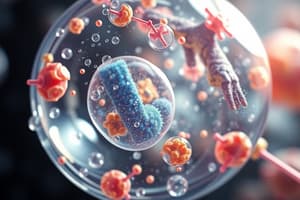Podcast
Questions and Answers
What happens to a plant cell placed in a hypertonic solution?
What happens to a plant cell placed in a hypertonic solution?
- The cell will lose water and shrink. (correct)
- The cell will remain unchanged.
- The cell will burst.
- The cell will take in water and swell.
Which of the following is NOT a characteristic of osmosis?
Which of the following is NOT a characteristic of osmosis?
- Movement from a region of high water concentration to low water concentration.
- Driven by differences in solute concentration.
- Movement of water across a selectively permeable membrane.
- Requires energy input from the cell. (correct)
What is the primary function of mitosis in multicellular organisms?
What is the primary function of mitosis in multicellular organisms?
- Production of gametes for sexual reproduction.
- Growth, repair, and asexual reproduction. (correct)
- Increasing genetic diversity.
- Reduction of chromosome number.
Which of the following best describes the process of meiosis?
Which of the following best describes the process of meiosis?
During which phase of mitosis do sister chromatids separate and move to opposite poles of the cell?
During which phase of mitosis do sister chromatids separate and move to opposite poles of the cell?
How does osmosis contribute to the maintenance of cell volume?
How does osmosis contribute to the maintenance of cell volume?
What is the effect of placing an animal cell in a hypotonic solution?
What is the effect of placing an animal cell in a hypotonic solution?
Which of the following statements correctly describes the role of crossing over in meiosis?
Which of the following statements correctly describes the role of crossing over in meiosis?
Flashcards
Cell
Cell
The basic structural and functional unit of all living organisms.
Osmosis
Osmosis
Movement of water across a selectively permeable membrane from high to low water concentration.
Isotonic Solution
Isotonic Solution
A solution with the same solute concentration as the cell’s cytoplasm.
Hypotonic Solution
Hypotonic Solution
Signup and view all the flashcards
Hypertonic Solution
Hypertonic Solution
Signup and view all the flashcards
Mitosis
Mitosis
Signup and view all the flashcards
Meiosis
Meiosis
Signup and view all the flashcards
Crossing Over
Crossing Over
Signup and view all the flashcards
Study Notes
The Fundamental Unit of Life
- The cell is the basic structural and functional unit of all living organisms. It's the smallest unit capable of carrying out life processes.
- All living organisms are composed of one or more cells.
- Cells vary significantly in size, shape, and function.
- Cells are highly complex structures containing a variety of organelles that carry out specific tasks.
Osmosis
- Osmosis is the movement of water across a selectively permeable membrane from a region of high water concentration to a region of low water concentration.
- This movement is driven by differences in water potential.
- Osmosis is a crucial process for maintaining cell volume and function.
- The rate of osmosis is influenced by the size of the concentration gradient and the permeability of the membrane.
Isotonic Solutions
- An isotonic solution has the same concentration of solutes as the cell's cytoplasm.
- Water moves in and out of the cell at equal rates, maintaining cell volume.
- No net gain or loss of water from the cell.
Hypotonic Solutions
- A hypotonic solution has a lower concentration of solutes than the cell's cytoplasm.
- Water moves into the cell, causing the cell to swell and possibly burst (lyse).
- This can damage or destroy the cell depending on the organism.
Hypertonic Solutions
- A hypertonic solution has a higher concentration of solutes than the cell's cytoplasm.
- Water moves out of the cell, causing the cell to shrink (crenate).
- This can result in dehydration and cell dysfunction.
Mitosis
- Mitosis is a type of cell division that results in two genetically identical daughter cells.
- It's essential for growth, repair, and asexual reproduction in many organisms.
- Mitosis involves a series of phases: prophase, metaphase, anaphase, and telophase.
- Each phase is characterized by specific events that ensure accurate duplication and separation of genetic material.
- The outcome is two identical diploid daughter cells.
Meiosis
- Meiosis is a type of cell division that produces four genetically unique haploid daughter cells.
- It's crucial for sexual reproduction as it reduces the chromosome number by half, allowing for the combination of genetic material from two parents.
- Meiosis involves two rounds of cell division (meiosis I and meiosis II).
- Crossing over between homologous chromosomes occurs in meiosis I, increasing genetic variability.
- Meiosis produces gametes (sperm and egg cells) for sexual reproduction; each gamete contains half the number of chromosomes as the parent cell.
Studying That Suits You
Use AI to generate personalized quizzes and flashcards to suit your learning preferences.




